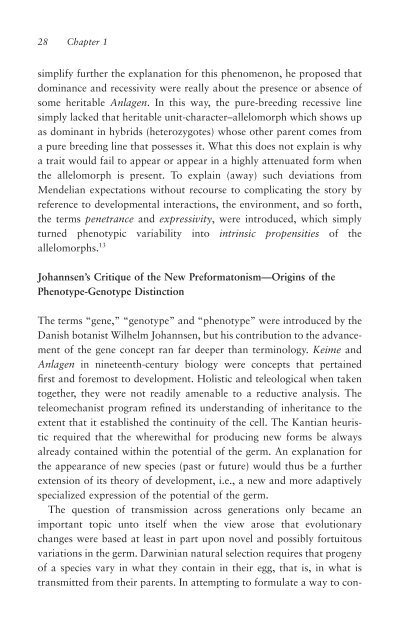A Critique of Pure (Genetic) Information
A Critique of Pure (Genetic) Information
A Critique of Pure (Genetic) Information
Create successful ePaper yourself
Turn your PDF publications into a flip-book with our unique Google optimized e-Paper software.
28 Chapter 1<br />
simplify further the explanation for this phenomenon, he proposed that<br />
dominance and recessivity were really about the presence or absence <strong>of</strong><br />
some heritable Anlagen. In this way, the pure-breeding recessive line<br />
simply lacked that heritable unit-character–allelomorph which shows up<br />
as dominant in hybrids (heterozygotes) whose other parent comes from<br />
a pure breeding line that possesses it. What this does not explain is why<br />
a trait would fail to appear or appear in a highly attenuated form when<br />
the allelomorph is present. To explain (away) such deviations from<br />
Mendelian expectations without recourse to complicating the story by<br />
reference to developmental interactions, the environment, and so forth,<br />
the terms penetrance and expressivity, were introduced, which simply<br />
turned phenotypic variability into intrinsic propensities <strong>of</strong> the<br />
allelomorphs. 13<br />
Johannsen’s <strong>Critique</strong> <strong>of</strong> the New Preformatonism—Origins <strong>of</strong> the<br />
Phenotype-Genotype Distinction<br />
The terms “gene,” “genotype” and “phenotype” were introduced by the<br />
Danish botanist Wilhelm Johannsen, but his contribution to the advancement<br />
<strong>of</strong> the gene concept ran far deeper than terminology. Keime and<br />
Anlagen in nineteenth-century biology were concepts that pertained<br />
first and foremost to development. Holistic and teleological when taken<br />
together, they were not readily amenable to a reductive analysis. The<br />
teleomechanist program refined its understanding <strong>of</strong> inheritance to the<br />
extent that it established the continuity <strong>of</strong> the cell. The Kantian heuristic<br />
required that the wherewithal for producing new forms be always<br />
already contained within the potential <strong>of</strong> the germ. An explanation for<br />
the appearance <strong>of</strong> new species (past or future) would thus be a further<br />
extension <strong>of</strong> its theory <strong>of</strong> development, i.e., a new and more adaptively<br />
specialized expression <strong>of</strong> the potential <strong>of</strong> the germ.<br />
The question <strong>of</strong> transmission across generations only became an<br />
important topic unto itself when the view arose that evolutionary<br />
changes were based at least in part upon novel and possibly fortuitous<br />
variations in the germ. Darwinian natural selection requires that progeny<br />
<strong>of</strong> a species vary in what they contain in their egg, that is, in what is<br />
transmitted from their parents. In attempting to formulate a way to con-
















